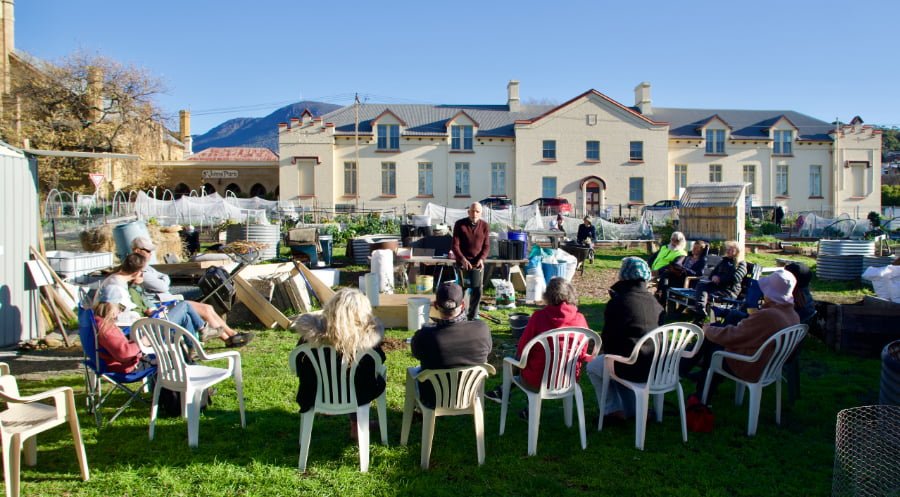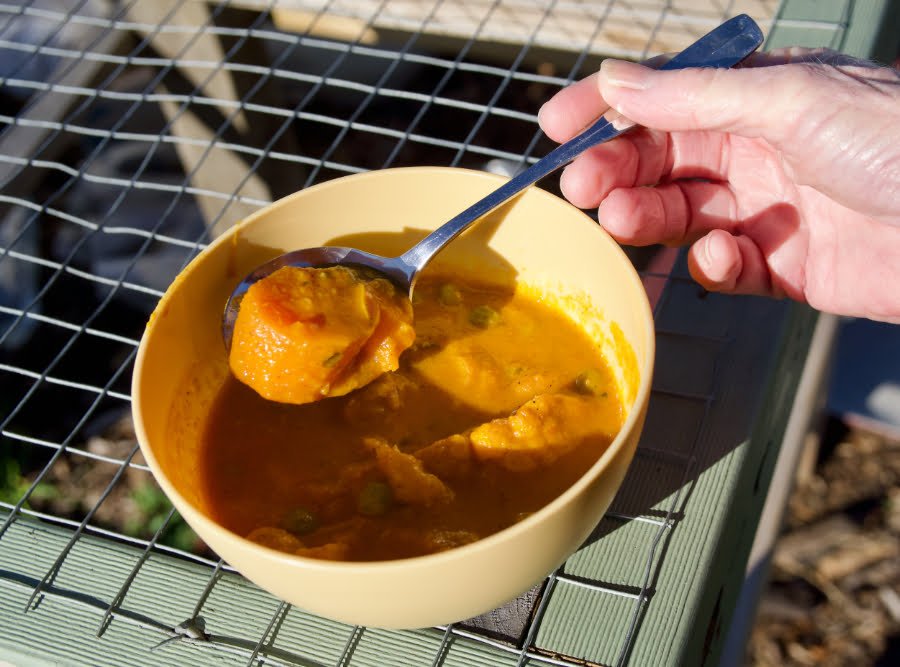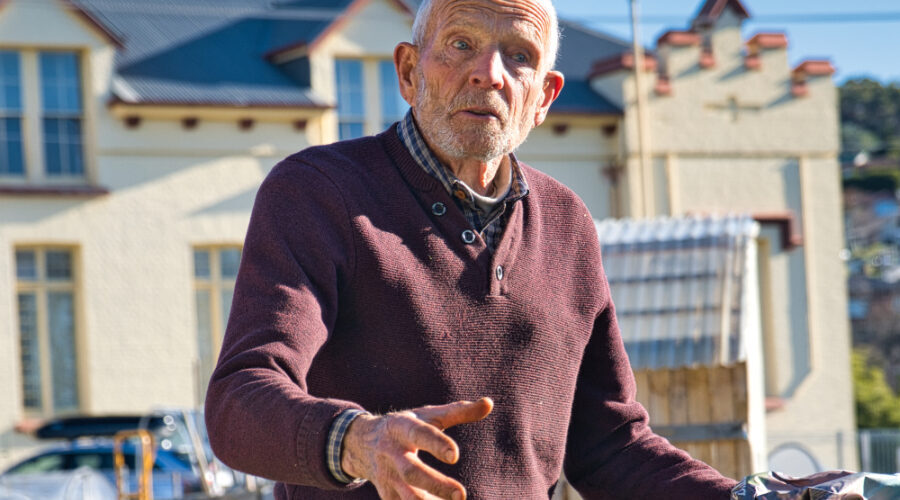Composting with the master gardener
Story and photos by Russ Grayson (feature image: David holds compost parcel)
IF YOU ARE a legendary master gardener whose specialisation is compost, what better way to spend a winter’s day than running a compost-making forum?
It is one of those fine, crisp Tasmanian winter mornings when the air is fresh and clear. We park and walk along an avenue of deciduous trees now leafless, their bare skeleton form silhouetted against the cloudless sky. Our destination is the David Stephen Neighbourhood Garden which occupies an elevated site open to the light of the east and north, and from where a sweeping view to the forested hills across the Derwent that mark the eastern boundary of this, Australia’s most southern city is seen.

The garden is across the road from the historic St Johns Anglican Church whose square spire is a local landmark. It is a convict-built structure dating from 1834 that was built of sandstone and timber harvested on nearby kunanyi-Mt Wellington. The adjacent building from the same era houses Kickstart Art Network.
A mosaic of raised garden beds managed by organic growing methods, multiple compost systems and a couple of storage sheds brings community agriculture to the city in this garden. Large wire mesh enclosures hold the leaf fall of those deciduous trees we walked below, material destined to become compost to feed the garden. Nearby, a chipper to chew up foliage and branches into mulch. Nipaluna Nursery, a community Landcare enterprise producing native Tasmanian plants for environmental rehabilitation, and of which Taroona Community Garden member, Nel Smit, is a member, occupies a corner of the site.
And there, ready to lead today’s compost forum is that legendary master gardener I mentioned—David Stephen David is an 83-year-old whose apparent fitness can be attributed to a lifetime spent in the garden. He is one of those wiry, healthy, suntanned characters whom someone described as ‘earthy’.

Around 40 people, some from the garden and some not, are gathered for the forum in superbly fine but occasionally windy Hobart weather that carries just enough chill to remind us that, yes, it is winter in this city. Questions and answers punctuate the demonstration of the various ways to make compost that David takes us through. How to make compost parcels, how to improve the layering technique—the alternating green material/brown material method of layered compost making that has been popularised—as well as burying, in-ground compost pots, the use of aeration tubes in large compost systems and more are covered.

So is compost paths, a method I have seen in other community gardens in which paths are made of a thick layer of bark chips. The chips break down as they age and weather, after which the decomposing material is used as compost. David explained that he first excavates the paths, spading soil onto the adjacent garden beds and then fills the paths with bark chip.
David Stephen is well-known in Tasmanian gardening circles for his expertise. I first encountered him in 2010 following the Tasmanian Community Gardens Network conference in Devonport. We were visiting The Source, the then-food co-op at the university which had a large vegetable garden around it, and there was David. I mentioned meeting him in a story I wrote about The Source: “Over at one end of the site is a new brick oven in which pizzas were in preparation for lunch that mild, mid-autumn day. Notable in the garden crew working that day was David Stephen, a veteran Tasmanian organic gardener. David was working on the compost system and explained that compost was something he likes being associated with. Wherever you find urban food growing in Hobart, you are likely to find David.”
Just like that fine autumn day now 13 years ago, here again, is David still working with his favourite substance, compost. He truly is the elder of community gardening on this island.
Making the event even more convivial was the lunch put on by the gardeners that included sweet potato and other ingredients grown in the garden. With a choice of a bean dish or a spicy soup called sweet potato korma, I chose the latter. It was delicious. Chicken sausage rolls were also on offer with tea and chocolate brownies or coconut cake to follow.

Before it became David Steven Neighbourhood Garden in 2023, the garden was known as Kickstart Neighbourhood Garden, and before that, the soil here was cultivated by the crew of Hobart City Farm, a small urban farming enterprise. It was renamed in 2023 in recognition of David’s contribution to gardening and community food production.
Afternoon’s coolth started to set in as the sun sank towards the imposing bulk of kunanyi-Mt Wellington. In the clear transparent light of the Tasmanian afternoon, across the Derwent, the rounded mass of Mt Direction took on that intense blueish colouration that is peculiar to winter in these southern latitudes. It was time to go.
Note: David will lead another compost forum in the garden in November.

